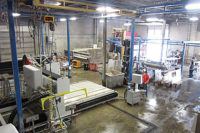And while this description may conjure up a classic stereotype, it is also quite inaccurate. As someone who has been covering our trade for Stone World for over 12 years, I have personally seen the industry thoughtfully embrace new technology over the course of time. One of the first advances I saw was the widespread acceptance of diamond tooling, which has resulted in increased efficiency and productivity that more than makes up for the initial dollar investment.
The next major step was perhaps CNC technology. Ten years ago, I remember driving great distances just to see CNC routers cutting kitchen countertops. Sure, there were some CNC machines around for large architectural work - particularly in major stoneworking regions around the world - but to see them cutting granite for Mrs. Smith's kitchen was newsworthy stuff.
Today, however, I can think of at least a half dozen CNC fabricators within a few minutes' drive of my office in New Jersey, including one that I have walked to on occasion. And new companies are entering the sector on a continual basis. This issue of Stone World includes four such fabricators, including two that were using CNC technology from the first day they entered stone fabrication.
I should caution here that while CNC technology can be tremendously effective, a shop needs to assess whether or not its current and anticipated volume and type of work necessitates the investment. Two of the companies I mentioned above had expanded from other countertop trades into stone, and thus had a market in place. After all, the CNC machine needs to be running if it is going to pay for itself. There are many factors to consider when evaluating the investment, and these are addressed in this month's feature, “Are you ready to move to CNC?†(page 70).
The next technological wave appears to be digital templating. Systems for electronically measuring a jobsite and creating digital templates have been developed by several companies, and they are gaining more exposure and use over time. We look at several available systems in this issue, including a pair of case studies on firms that use this technology as the focal point of their trade. In a similar technological leap, computerized systems for estimating, inventory and job tracking are also becoming more and more common in the fabrication shop.
So as this technology continues to advance, we'll keep showing you examples right here in the pages of Stone World. Of course, even with this technology in hand, the need for craftsmanship in the stone trade remains critical. This thought was conveyed by virtually all of the CNC users we interviewed, so don't throw away the hammer and chisel (or the newspaper hat) just yet.
